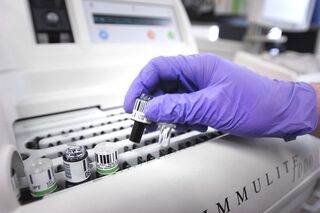Hormones
3 Unanswered Questions About Testosterone and Athletics
Testosterone levels are only important because that's what we know.
Posted May 26, 2020
Historically, hormone level has been the easiest aspect of the hormone system to manipulate. Scientists simply removed the organ that produces the hormone of interest then used injections to control hormone levels. While scientists do not manipulate hormones in humans, measuring hormone levels like testosterone (T) simply requires a small amount of spit. As a result, the bulk of our understanding of hormones like T is based on the levels circulating in the blood.
How T levels influence the body is certainly an important topic of research. Unfortunately, data from these studies have been used to justify discrimination against transgender and intersex individuals in sports even though other factors related to T remain unexamined. This is not because they are irrelevant to athletic performance but because they are trickier to manipulate and understand.
Here are three unanswered questions regarding T that sports authorities and scientists fail to explore when calling for hormone screening of athletes:
How are receptors for testosterone involved?
Hormone level would be meaningless without hormone receptors, the part of the hormone system that lets hormones influence cells. Cells in our muscles can use the androgen receptor to detect T levels in the blood. Precise control and understanding of the androgen receptor and related measures in research requires contemporary technologies like genetically modified lab animals and gene sequencers. Compared to T level, we know relatively little about the androgen receptor.
The influence of T on the androgen receptor and then on the cell itself can vary based on many factors; differences in the androgen receptor gene [1], which proteins carry the androgen receptor around in the cell [2], and what happens in the cell after T is detected [3]. This means T affects people differently; in other words, the same level of T can mean vastly different things for each individual person. Indeed, even though females have drastically lower levels of T than males, it still has significant control over bodily functions.
Another important aspect of androgen receptor function is their location. We know that separate muscles have variable sensitivity to T [4] and this may differ between individuals. Depending on which muscles are most sensitive, the same T level may significantly benefit athletic performance in some individuals but not others even within the same field.
Directly measuring T levels will not reveal everyone who benefits from T.
When do training and performance benefit most from testosterone?

There are two factors to consider here. The first is variation in T levels across time and the second is when T has the greatest influence over the body.
Both males and females produce T, and close examinations of T level show changes daily and across the lifespan [5]. Scientists can control for daily fluctuations by collecting data at the same time but this does not mean the same levels were present throughout training. T levels could be elevated before, after, or during training periods and each of these may have unique implications for athletic capacity requiring research.
Lifelong changes in T may be important as well. Sometimes T only affects certain aspects of anatomy at specific time points in development called sensitive periods [6]. The level of T during a sensitive period may be more important than any measurements performed before or after. That means changes in T outside sensitive periods may not always influence sports performance.
A limited history of hormone levels cannot predict athletic ability.
Do social influences on testosterone matter?
One of the more fascinating findings regarding our hormonal systems is their involvement with social interactions. After social situations where a person of any sex expresses power over others, such as winning an athletic competition, a small temporary increase in T is seen [7]. Individuals who continually perform well may repeatedly receive a T increase.
While it is unlikely this T increase would benefit muscle performance, T level is thought to influence memory formation [8]. A large portion of sports performance involves attitude and forming powerful memories based on success in competition may influence emotions during events. Feeling empowered could improve athletic ability, regardless of sex or gender. In this case, the benefit provided by T could never show up in hormone screening.
Even the most logical researchers must admit procedural limitations unbalanced our grasp of T signaling, biasing it towards hormone level. As a result of our focus on hormone level, some athletes may not benefit from T but are still excluded from a sport. Others may have benefited from T but easily pass hormone screening.
When we look beyond hormone level, the possibility that some cisgender athletes benefit from T more than others is obvious. Indeed, all these data (and more) suggest T can provide various benefits to individuals regardless of T level, sex, or gender identity. Yet, only the transgender and intersex communities are targeted for hormone screening. Until researchers ask how all athletes may benefit from T or sports authorities stop relying on T level, we are unfairly punishing sex and gender minorities based on limited research.
References
1. Beilin, J., et al., Effect of the androgen receptor CAG repeat polymorphism on transcriptional activity: specificity in prostate and non-prostate cell lines. Journal of molecular endocrinology, 2000. 25(1): p. 85-96.
2. Prescott, J. and G.A. Coetzee, Molecular chaperones throughout the life cycle of the androgen receptor. Cancer letters, 2006. 231(1): p. 12-19.
3. Sun, J., et al., Cofactor of BRCA1 modulates androgen-dependent transcription and alternative splicing. The Journal of steroid biochemistry and molecular biology, 2007. 107(3-5): p. 131-139.
4. Johansen, J., S. Breedlove, and C. Jordan, Androgen receptor expression in the levator ani muscle of male mice. Journal of neuroendocrinology, 2007. 19(10): p. 823-826.
5. Shansky, R.M., Are hormones a “female problem” for animal research? Science, 2019. 364(6443): p. 825-826.
6. Breedlove, S.M. and A.P. Arnold, Hormonal control of a developing neuromuscular system. II. Sensitive periods for the androgen-induced masculinization of the rat spinal nucleus of the bulbocavernosus. Journal of Neuroscience, 1983. 3(2): p. 424-432.
7. van Anders, S.M., J. Steiger, and K.L. Goldey, Effects of gendered behavior on testosterone in women and men. Proceedings of the National Academy of Sciences, 2015. 112(45): p. 13805-13810.
8. Van Anders, S.M., K.L. Goldey, and P.X. Kuo, The steroid/peptide theory of social bonds: integrating testosterone and peptide responses for classifying social behavioral contexts. Psychoneuroendocrinology, 2011. 36(9): p. 1265-1275.




